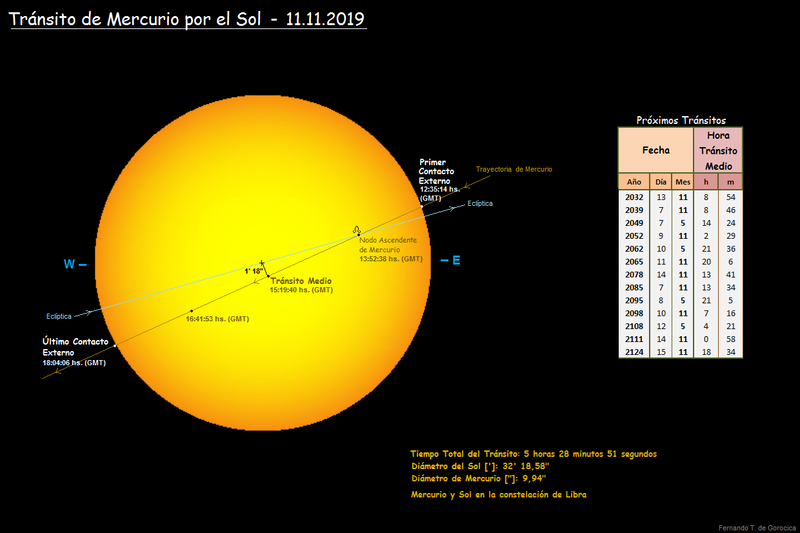File:Tránsito de Mercurio del 11 de Noviembre de 2019.png

Original file (1,240 × 826 pixels, file size: 149 KB, MIME type: image/png)
Captions
Captions
Summary[edit]
| DescriptionTránsito de Mercurio del 11 de Noviembre de 2019.png |
Español: TRÁNSITO DE MERCURIO DEL 11.11.2019. El Lunes 11.11.2019 desde las 09:35 hs. hasta las 15:04 hs. hora local Argentina, se podrá observar el tránsito de Mercurio por el disco solar. Desde la Ciudad Autónoma de Buenos Aires: SOL: MERCURIO: A las 10:52:38 hs. Mercurio pasará por su nodo orbital ascendente aparente, es decir desde las Latitudes Eclípticas Geocéntricas negativas a las positivas (0°), su Longitud Eclíptica Geocéntrica será de 229° 0’ 48,16”. También la Latitud Heliocéntrica será muy próxima a 0° (nodo orbital ascendente verdadero de Mercurio) y su Longitud Heliocéntrica 48° 34' 7,79". Las horas son válidas para todo el país, las alturas y azimuts aproximadamente para toda la costa bonaerense y el litoral argentino. Este evento se lo puede observar con un telescopio tanto reflector como refractor, pero adaptando un filtro solar en el objetivo (boca del tubo), generalmente film Mylar o mejor, filtro Baader. Evitar filtros en el ocular. También proyectando el Sol en una pantalla blanca haciendo foco en la misma. Por ejemplo, el planeta se lo podrá resolver con un ocular de 14 mm (71 aumentos) y como un puntito redondo muy pequeño. ¡¡¡CUIDADO DE OBSERVAR EL SOL POR EL OCULAR Y SIN FILTRO!!!, PUEDE PRODUCIR DAÑOS EN LA VISIÓN O CEGUERA PERMANENTE!!!... CONDICIONES GENERALES DEL TRÁNSITO: El tránsito de Mercurio “sobre” el disco solar ocurre cuando el planeta se encuentra en o muy cerca de alguno de sus dos nodos, tanto ascendente como descendente, además de tener una elongación, es decir el ángulo Sol-Mercurio-Tierra de 0º (Conjunción Inferior). El movimiento aparente del tránsito de Mercurio es retrógrado respecto al solar y esto se debe a los dos movimientos en conjunto de la Tierra y de Mercurio entorno al Sol, siendo el de Mercurio más rápido que el terrestre. SOL y MERCURIO en la constelación de LIBRA. Ver datos en imagen adjunta y sus próximos tránsitos. Ver más sobre los tránsitos de Mercurio y Venus. |
| Date | |
| Source | Own work y datos del "M1 Sistema Astronómico"©. |
| Author | Fernando de Gorocica |
Licensing[edit]
- You are free:
- to share – to copy, distribute and transmit the work
- to remix – to adapt the work
- Under the following conditions:
- attribution – You must give appropriate credit, provide a link to the license, and indicate if changes were made. You may do so in any reasonable manner, but not in any way that suggests the licensor endorses you or your use.
- share alike – If you remix, transform, or build upon the material, you must distribute your contributions under the same or compatible license as the original.
File history
Click on a date/time to view the file as it appeared at that time.
| Date/Time | Thumbnail | Dimensions | User | Comment | |
|---|---|---|---|---|---|
| current | 18:37, 7 July 2018 |  | 1,240 × 826 (149 KB) | Fernando de Gorocica (talk | contribs) | User created page with UploadWizard |
You cannot overwrite this file.
File usage on Commons
The following page uses this file:
Metadata
This file contains additional information such as Exif metadata which may have been added by the digital camera, scanner, or software program used to create or digitize it. If the file has been modified from its original state, some details such as the timestamp may not fully reflect those of the original file. The timestamp is only as accurate as the clock in the camera, and it may be completely wrong.
| Horizontal resolution | 37.79 dpc |
|---|---|
| Vertical resolution | 37.79 dpc |